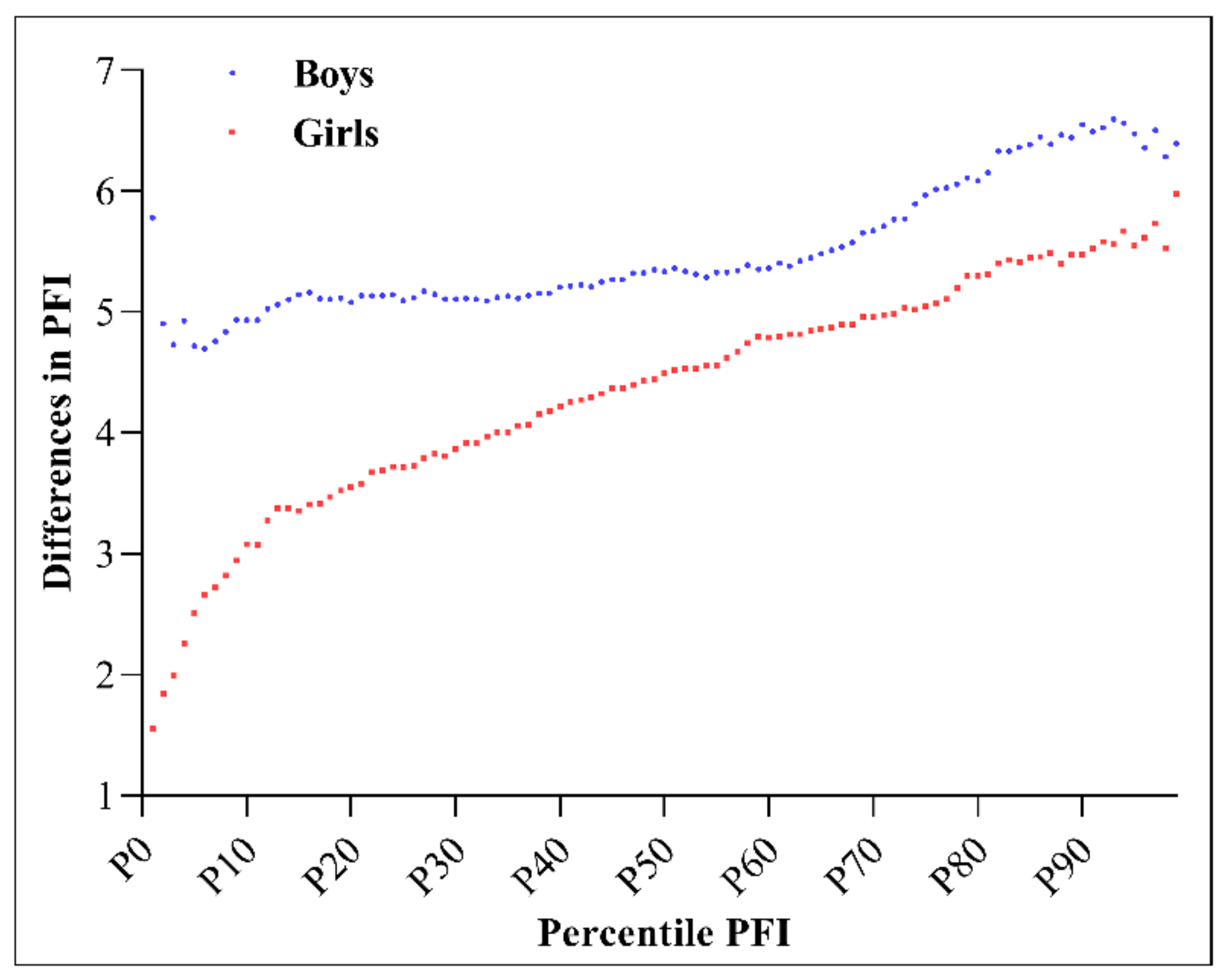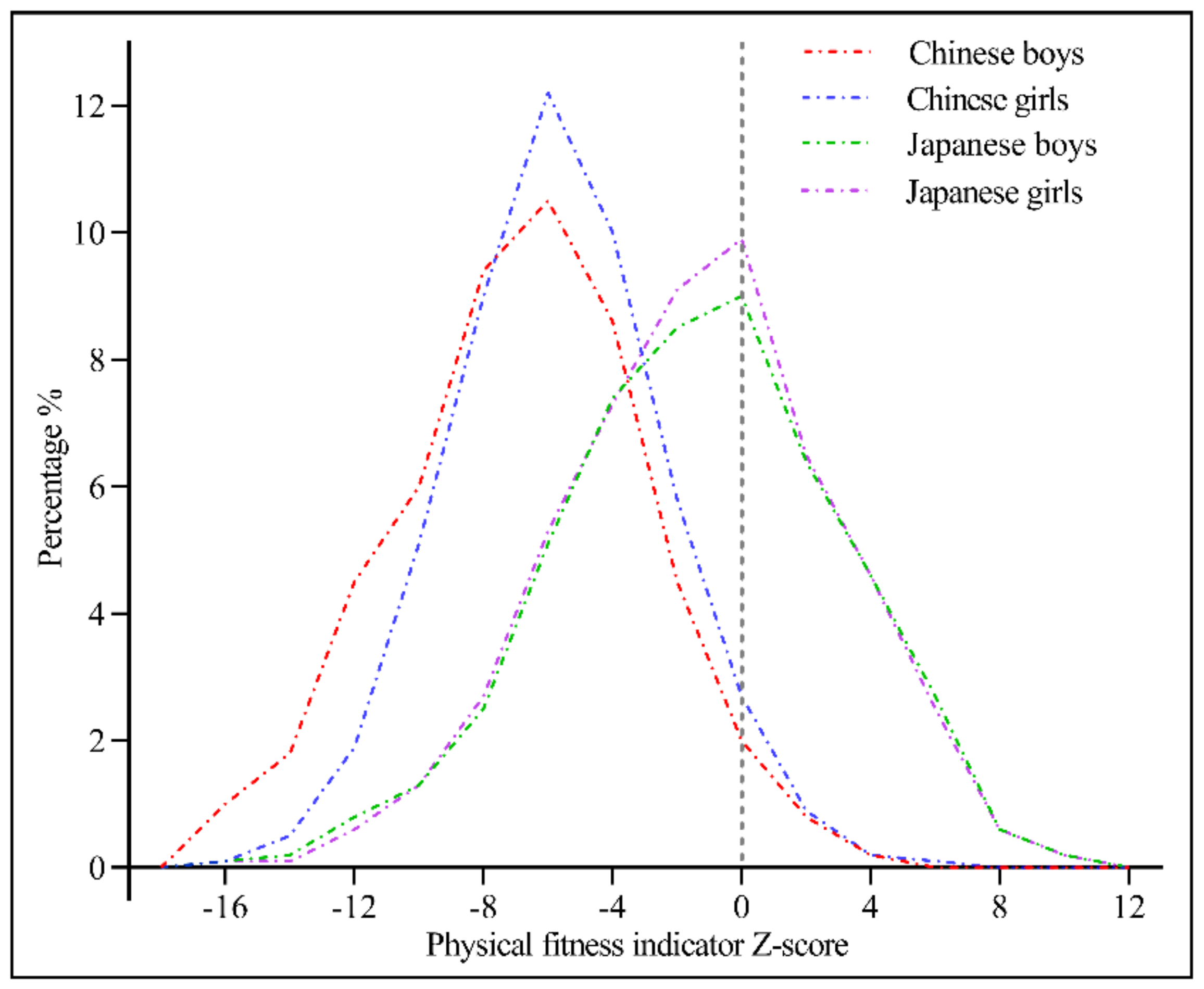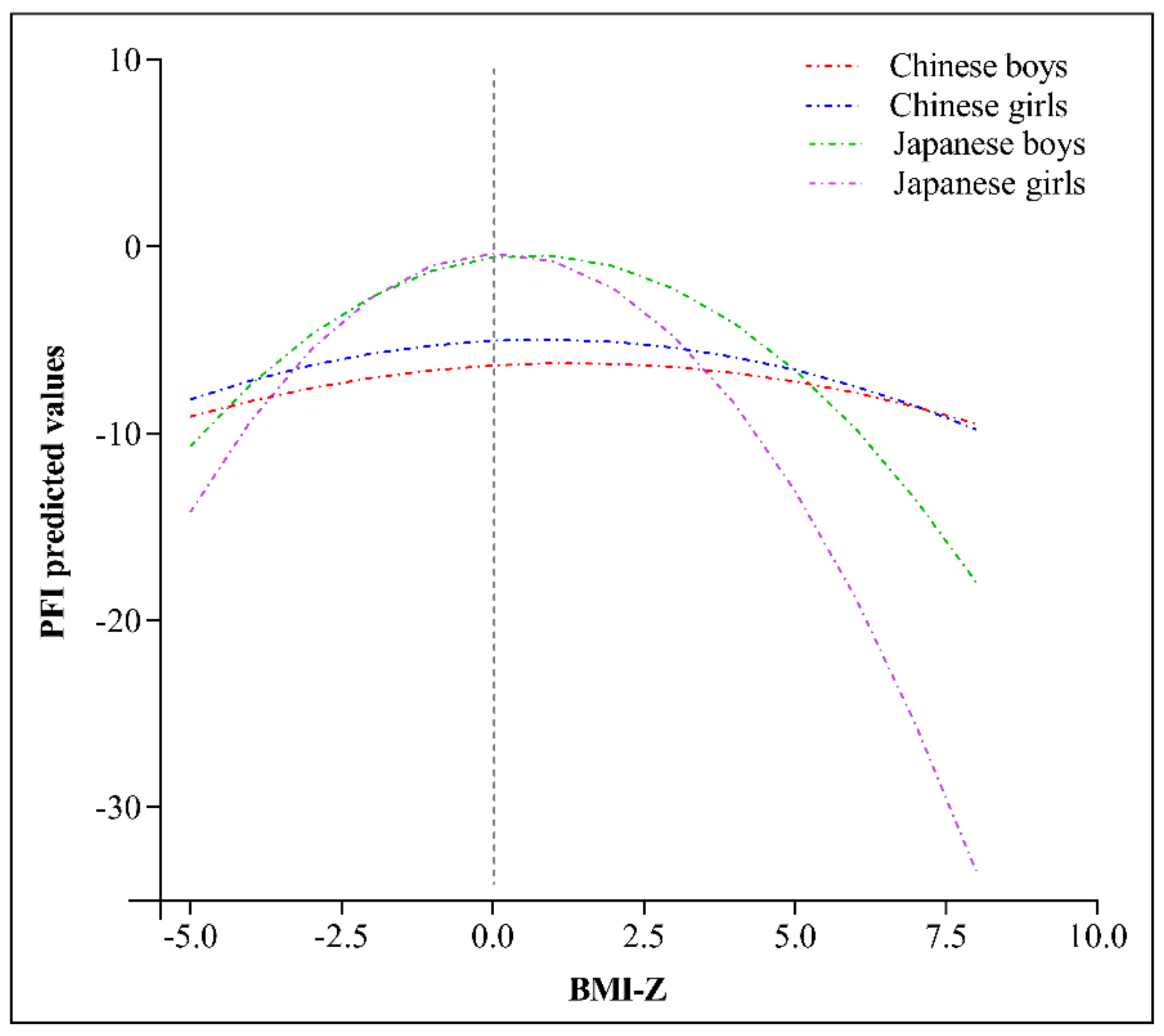Levels of Physical Fitness and Weight Status in Children and Adolescents: A Comparison between China and Japan
Abstract
1. Introduction
2. Materials and Methods
2.1. Participants and Ethical Considerations
2.2. Procedure and Measurement
2.3. Nutritional Status and PFI
2.4. Statistical Analyses
3. Results
4. Discussion
5. Conclusions
Author Contributions
Funding
Acknowledgments
Conflicts of Interest
References
- He, B.M.; Chen, R.; Sun, T.Q.; Yang, Y.; Zhang, C.L.; Ren, S.C.; Gao, X.; Sun, Y.H. Prostate cancer risk prediction models in Eastern Asian populations: Current status, racial difference, and future directions. Asian J. 2020, 22, 158–161. [Google Scholar]
- Maruyama, H.; Ujiie, T.; Takai, J.; Takahama, Y.; Sakagami, H.; Shibayama, M.; Fukumoto, M.; Ninomiya, K.; Ah, P.H.; Feng, X.; et al. Cultural Difference in Conflict Management Strategies of Children and Its Development: Comparing 3- and 5-Year-Olds across China, Japan, and Korea. Early Educ. Dev. 2015, 26, 1210–1233. [Google Scholar] [CrossRef] [PubMed][Green Version]
- Zhou, B.F.; Stamler, J.; Dennis, B.; Moag-Stahlberg, A.; Okuda, N.; Robertson, C.; Zhao, L.; Chan, Q.; Elliott, P.; INTERMAP Research Group. Nutrient intakes of middle-aged men and women in China, Japan, United Kingdom, and United States in the late 1990s: The INTERMAP study. J. Hum. Hypertens. 2003, 17, 623–630. [Google Scholar] [CrossRef] [PubMed]
- Noh, J.W.; Kim, J.; Yang, Y.; Park, J.; Cheon, J.; Kwon, Y.D. Body mass index and self-rated health in East Asian countries: Comparison among South Korea, China, Japan, and Taiwan. PLoS ONE 2017, 12, e0183881. [Google Scholar] [CrossRef] [PubMed]
- Yamakita, M.; Sato, M.; Suzuki, K.; Ando, D.; Yamagata, Z. Sex Differences in Birth Weight and Physical Activity in Japanese Schoolchildren. J. Epidemiol. 2018, 28, 331–335. [Google Scholar] [CrossRef] [PubMed]
- Zhang, Z.; Zhang, L.; Li, H. A meta-analysis of the physical activity status of children and adolescents in China. Chin. J. Sch. Health 2020, 41, 173–178. [Google Scholar]
- United Nations Development Programme. Human Development Reports. 2014. Available online: http://hdr.undp.org/en/data# (accessed on 20 April 2020).
- The World Bank. Urban Population (% of Total). Available online: http://data.worldbank.org/indicator/SP.URB.TOTL.IN.ZS?display=default (accessed on 20 April 2020).
- Ortega, F.B.; Ruiz, J.R.; Castillo, M.J.; Sjostrom, M. Physical fitness in childhood and adolescence: A powerful marker of health. Int. J. Obes. (Lond.) 2008, 32, 1–11. [Google Scholar] [CrossRef]
- Dong, Y.; Lau, P.W.C.; Dong, B.; Zou, Z.; Yang, Y.; Wen, B.; Ma, Y.; Hu, P.; Song, Y.; Ma, J.; et al. Trends in physical fitness, growth, and nutritional status of Chinese children and adolescents: A retrospective analysis of 1·5 million students from six successive national surveys between 1985 and 2014. Lancet Child Adolesc. Health 2019, 3, 871–880. [Google Scholar] [CrossRef]
- Ministry of Education, Culture, Sports, Science and Technology. The Report of Survey on Physical Strength and Athletic Performance. Available online: http://www.mext.go.jp/a_menu/sports/kodomo/zencyo/1342657.htm (accessed on 20 April 2020).
- Guo, Y.; Yin, X.; Wu, H.; Chai, X.; Yang, X. Trends in Overweight and Obesity among Children and Adolescents in China from 1991 to 2015: A Meta-Analysis. Int. J. Environ. Res. Public Health 2019, 16, 4656. [Google Scholar] [CrossRef]
- Wakamatsu, M.; Sugawara, Y.; Zhang, S.; Tanji, F.; Tomata, Y.; Tsuji, I. Weight change since age 20 and incident risk of obesity-related cancer in Japan: A pooled analysis of the Miyagi Cohort Study and the Ohsaki Cohort Study. Int. J. Cancer 2019, 144, 967–980. [Google Scholar] [CrossRef]
- Shao, J.; Sun, Y.; Yin, X.; Li, Y.; Akira, S. Association between body mass index and physical fitness index in Chinese and Japanese children and adolescents. Chin. J. Sch. Health 2019, 40, 1616–1619. [Google Scholar]
- Tomkinson, G.R.; Macfarlane, D.; Noi, S.; Kim, D.Y.; Wang, Z.Z.; Hong, R. Temporal Changes in Long-Distance Running Performance of Asian Children between 1964 and 2009. Sports Med. 2012, 42, 267–279. [Google Scholar] [CrossRef] [PubMed]
- Yang, X.; Yin, X.; Ji, L.; Song, G.; Wu, H.; Li, Y.; Wang, G.; Bi, C.; Sun, Y.; Li, M.; et al. Differences in Cardiorespiratory Fitness between Chinese and Japanese Children and Adolescents. Int. J. Environ. Res. Public Health 2019, 16, 2316. [Google Scholar] [CrossRef] [PubMed]
- Hui, S.S.; Zhang, R.; Suzuki, K.; Naito, H.; Balasekaran, G.; Song, J.K.; Park, S.Y.; Liou, Y.M.; Lu, D.; Poh, B.K.; et al. Physical activity and health-related fitness in Asian adolescents: The Asia-fit study. J. Sports Sci. 2020, 38, 273–279. [Google Scholar] [CrossRef] [PubMed]
- Bi, C.; Zhang, F.; Gu, Y.; Song, Y.; Cai, X. Secular Trend in the Physical Fitness of Xinjiang Children and Adolescents between 1985 and 2014. Int. J. Environ. Res. Public Health 2020, 17, 2195. [Google Scholar] [CrossRef]
- Japanese Sports Bureau of the Ministry of Education. 2008. Available online: https://www.mext.go.jp/sports/content/1408001_1.pdf (accessed on 20 April 2020).
- Japanese Sports Bureau of the Ministry of Education. 2008. Available online: https://www.mext.go.jp/sports/content/1408001_2.pdf (accessed on 20 April 2020).
- Yin, X.; Yang, X.; Ji, L.; Song, G.; Wu, H.; Li, Y.; Sun, Y.; Bi, C.; Li, M.; Zhang, T.; et al. Comparison of growth and nutritional status of Chinese and Japanese children and adolescents. Ann. Hum. Biol. 2020, 47, 425–433. [Google Scholar] [CrossRef]
- Bonney, E.; Ferguson, G.; Smits-Engelsman, B. Relationship between Body Mass Index, Cardiorespiratory and Musculoskeletal Fitness among South African Adolescent Girls. Int. J. Environ. Res. Public Health 2018, 15, 1087. [Google Scholar] [CrossRef]
- World Health Organization. Global Recommendations on Physical Activity for Health; WHO: Geneva, Switzerland, 2010. [Google Scholar]
- Report of 2018 Active Healthy Kids Global Alliance. Available online: https://www.activehealthykids.org/japan/ (accessed on 10 December 2020).
- Report of 2018 Active Healthy Kids Global Alliance. Available online: https://www.activehealthykids.org/china/ (accessed on 10 December 2020).
- Yu, A.Y.L.; Lopez-Olmedo, N.; Popkin, B.M. Analysis of dietary trends in Chinese adolescents from 1991 to 2011. Asia Pac. J. Clin. Nutr. 2018, 27, 1106–1119. [Google Scholar]
- Jing, F.; Li, Y.; Fan, C. Association between sweetened beverages consumption and obesity in Chinese children and adolescents. Prev. Med. 2018, 30, 494–497. [Google Scholar]
- Kohri, T.; Kaba, N.; Itoh, T.; Sasaki, S. Effects of the National School Lunch Program on Bone Growth in Japanese Elementary School Children. J. Nutr. Sci. Vitaminol. 2016, 62, 303–309. [Google Scholar] [CrossRef]
- Sandercock, G.R.H.; Voss, C.; Dye, L. Associations between habitual school-day breakfast consumption, body mass index, physical activity and cardiorespiratory fitness in English schoolchildren. Eur. J. Clin. Nutr. 2010, 64, 1086–1092. [Google Scholar] [CrossRef] [PubMed]
- David, T.; Julien, A.; Laurie, I.; Nordine, L.; Sebastien, R.; Eric, D.; Martine, M.; Pascale, D. Are eating habits associated with physical fitness in primary school children? Eat. Behav. 2013, 14, 83–86. [Google Scholar] [CrossRef] [PubMed]
- Du, W.; Wang, H.; Wang, D.; Su, C.; Zhang, J.; Ouyang, Y.; Jia, X.; Huang, F.; Zhang, B. Meal and snack consumption among Chinese children and adolescents in twelve provinces. J. Hyg. Res. 2016, 45, 876–881. [Google Scholar]
- Murakami, K.; Livingstone, M.B.E.; Fujiwara, A.; Sasaki, S. Breakfast in Japan: Findings from the 2012 National Health and Nutrition Survey. Nutrients 2018, 10, 1551. [Google Scholar] [CrossRef] [PubMed]
- Villa-Gonzalez, E.; Ruiz, J.R.; Chillon, P. Associations between Active Commuting to School and Health-Related Physical Fitness in Spanish School-Aged Children: A Cross-Sectional Study. Int. J. Environ. Res. Public Health 2015, 12, 10362–10373. [Google Scholar] [CrossRef]
- Voss, C.; Sandercock, G. Aerobic Fitness and Mode of Travel to School in English Schoolchildren. Med. Sci. Sports Exerc. 2010, 42, 281–287. [Google Scholar] [CrossRef]
- Ramirez-Velez, R.; Garcia-Hermoso, A.; Agostinis-Sobrinho, C.; Mota, J.; Santos, R.; Enrique Correa-Bautista, J.; Constanza Amaya-Tambo, D.; Villa-Gonzalez, E. Cycling to School and Body Composition, Physical Fitness, and Metabolic Syndrome in Children and Adolescents. J. Pediatrics 2017, 188, 57–63. [Google Scholar] [CrossRef]
- Sun, Y.; Liu, Y.; Tao, F.B. Associations between Active Commuting to School, Body Fat, and Mental Well-being: Population-Based, Cross-Sectional Study in China. J. Adolesc. Health 2015, 57, 679–685. [Google Scholar] [CrossRef]
- Tanaka, C.; Tanaka, S.; Inoue, S.; Miyachi, M.; Suzuki, K.; Reilly, J.J. Results from Japan’s 2016 Report Card on Physical Activity for Children and Youth. J. Phys. Act. Health 2016, 13, S189–S194. [Google Scholar] [CrossRef]
- Wolfe, A.M.; Lee, J.A.; Laurson, K.R. Socioeconomic status and physical fitness in youth: Findings from the NHANES National Youth Fitness Survey. J. Sports Sci. 2020, 38, 534–541. [Google Scholar] [CrossRef]
- Pavon, D.J.; Ortega, F.P.; Ruiz, J.R.; Romero, V.E.; Artero, E.G.; Urdiales, D.M.; Martinez, S.G.; Rodriguez, G.V.; Manios, Y.; Beghin, L.; et al. Socioeconomic status influences physical fitness in European adolescents independently of body fat and physical activity: The HELENA Study. Nutr. Hosp. 2010, 25, 311–316. [Google Scholar]
- Bowser, J.; Martinez-Donate, A.P.; Carrel, A.; Allen, D.B.; Moberg, D.P. Disparities in Fitness and Physical Activity among Children. WMJ Off. Publ. State Med. Soc. Wis. 2016, 115, 245–250. [Google Scholar]
- Hu, A.; Shi, Z.; Tang, X. The continues decreased and influencing factors of HDI difference in China. J. Xinjiang Norm. Univ. (Philos. Soc. Sci.) 2018, 39, 47–55. [Google Scholar]
- Huang, Y.-C.; Malina, R.M. BMI and Health-Related Physical Fitness in Taiwanese Youth 9–18 Years. Med. Sci. Sports Exerc. 2007, 39, 701–708. [Google Scholar] [CrossRef] [PubMed]





| China | Japan | t/χ2 | p-Values | |||||
|---|---|---|---|---|---|---|---|---|
| Boys | Girls | Total | Boys | Girls | Total | |||
| Sample size (%) | 2850 (50.4) | 2810 (49.6) | 5660 | 2847 (50.3) | 2813 (49.7) | 5660 | / | / |
| Age groups (years) | ||||||||
| 7–9 (%) | 731 (50.7) | 712 (49.3) | 1443 | 696 (50.4) | 684 (49.6) | 1380 | / | / |
| 10–12 (%) | 711 (50.1) | 709 (49.9) | 1420 | 695 (49.9) | 697 (50.1) | 1392 | / | / |
| 13–15 (%) | 704 (50.9) | 680 (49.1) | 1384 | 734 (50.8) | 711 (49.2) | 1445 | / | / |
| 16–18 (%) | 704 (49.8) | 709 (50.2) | 1413 | 722 (50.0) | 721 (50.0) | 1443 | / | / |
| Nutritional status | ||||||||
| Height (cm, SD) | 154.3 (19.2) | 149.6 (14.9) | 152 (17.4) | 151.1 (18.2) | 146.1 (13.8) | 148.6 (16.3) | 10.728 | <0.01 |
| Weight (kg, SD) | 48.3 (18.2) | 43.1 (13.7) | 45.7 (16.4) | 43.8 (15.1) | 40.2 (11.5) | 42.0 (13.6) | 13.065 | <0.01 |
| BMI (kg/m2, SD) | 19.5 (4.0) | 18.7 (3.4) | 19.1 (3.7) | 18.5 (2.9) | 18.4 (2.8) | 18.4 (2.9) | 11.202 | <0.01 |
| Stunting (%) | 72 (2.5) | 75 (2.7) | 147 (2.6) | 143 (5.0) | 179 (6.4) | 322 (5.7) | 68.12 | <0.01 |
| Thinness (%) | 56 (2.0) | 31 (1.1) | 87 (1.5) | 11 (0.4) | 11 (0.4) | 22 (0.4) | 39.14 | <0.01 |
| Normal weight (%) | 1835 (64.4) | 2203 (78.4) | 4038 (71.3) | 2247 (78.9) | 2331 (82.9) | 4578 (80.9) | 141.68 | <0.01 |
| Overweight (%) | 384 (13.5) | 289 (10.3) | 673 (11.9) | 274 (9.6) | 223 (7.9) | 497 (8.8) | 29.53 | <0.01 |
| Obese (%) | 518 (18.2) | 221 (7.9) | 739 (13.1) | 179 (6.3) | 80 (2.8) | 259 (4.6) | 253.18 | <0.01 |
| Physical fitness items | ||||||||
| Grip strength (kg, SD) | 25.2 (13.2) | 18.7 (7.5) | 22.0 (11.2) | 26.1 (12.5) | 20.1 (7.3) | 23.1 (10.7) | −5.343 | <0.01 |
| 30-s sit-ups (SD) | 22.5 (6.5) | 21.1 (5.7) | 21.8 (6.1) | 25.6 (8.8) | 21.1 (7.1) | 23.4 (8.3) | −11.686 | <0.01 |
| Standing long jump (cm, SD) | 175 (39.7) | 150.1 (22.1) | 162.7 (34.5) | 181.4 (42.8) | 154.2 (29.0) | 167.9 (39) | −7.513 | <0.01 |
| Sit-and-reach (cm, SD) | 35.4 (11.2) | 37.4 (10.5) | 36.4 (10.9) | 41.8 (12.2) | 42.9 (11.0) | 42.4 (11.6) | −28.358 | <0.01 |
| 20-s repeated straddling (SD) | 31.5 (9.8) | 29.4 (9.0) | 30.5 (9.4) | 47.7 (11.3) | 42 (8.4) | 44.8 (10.3) | −77.151 | <0.01 |
| 50-m dash (s, SD) | 8.9 (1.5) | 9.7 (1.1) | 9.3 (1.4) | 8.6 (1.4) | 9.3 (1.1) | 9.0 (1.3) | 11.814 | <0.01 |
| 20-m SRT (laps, SD) | 37.7 (21.6) | 27.3 (11.8) | 32.5 (18.2) | 66.2 (24.8) | 41.7 (14.2) | 54.0 (23.6) | −54.274 | <0.01 |
| Age (y) | China | Japan | χ2-A | χ2-B | χ2-C | ||||||
|---|---|---|---|---|---|---|---|---|---|---|---|
| N | Under Nutrition n (%) | Normal n (%) | Overnutrition n (%) | N | Under Nutrition n (%) | Normal, n (%) | Overnutrition n (%) | ||||
| Boys | |||||||||||
| 7–9 | 731 | 30 (4.1) | 439 (60.1) | 262 (35.8) | 696 | 32 (4.6) | 549 (78.9) | 115 (16.5) | 0.21 | 59.32 b | 68.45 b |
| 10–12 | 711 | 48 (6.8) | 390 (54.9) | 273 (38.4) | 695 | 31 (4.5) | 484 (69.6) | 180(25.9) | 3.48 | 32.68 b | 25.14 b |
| 13–15 | 704 | 32 (4.5) | 473 (67.2) | 199 (28.3) | 734 | 57 (7.8) | 582 (79.3) | 95 (12.9) | 6.42 a | 26.94 b | 51.88 b |
| 16–18 | 704 | 13 (1.8) | 533 (75.7) | 158 (22.4) | 722 | 32 (4.4) | 632 (87.5) | 58 (8.0) | 7.80 b | 33.33 b | 57.59 b |
| Girls | |||||||||||
| 7–9 | 712 | 22 (3.1) | 523 (73.5) | 167 (23.5) | 684 | 34 (5.0) | 553 (80.8) | 97 (14.2) | 3.21 | 10.79 b | 19.57 b |
| 10–12 | 709 | 57 (8.0) | 518 (73.1) | 134 (18.9) | 697 | 39 (5.6) | 565 (81.1) | 93 (13.3) | 3.30 | 12.72 b | 8.02 b |
| 13–15 | 680 | 11 (1.6) | 541 (79.6) | 128 (18.8) | 711 | 66 (9.3) | 566 (79.6) | 79 (11.1) | 39.05 b | 0.00 | 16.32 b |
| 16–18 | 709 | 11 (1.6) | 621 (87.6) | 77 (10.9) | 721 | 51 (7.1) | 647 (89.7) | 23 (3.2) | 26.28 b | 1.64 | 32.34 b |
Publisher’s Note: MDPI stays neutral with regard to jurisdictional claims in published maps and institutional affiliations. |
© 2020 by the authors. Licensee MDPI, Basel, Switzerland. This article is an open access article distributed under the terms and conditions of the Creative Commons Attribution (CC BY) license (http://creativecommons.org/licenses/by/4.0/).
Share and Cite
Li, Y.; Zhang, F.; Chen, Q.; Yin, X.; Bi, C.; Yang, X.; Sun, Y.; Li, M.; Zhang, T.; Liu, Y.; et al. Levels of Physical Fitness and Weight Status in Children and Adolescents: A Comparison between China and Japan. Int. J. Environ. Res. Public Health 2020, 17, 9569. https://doi.org/10.3390/ijerph17249569
Li Y, Zhang F, Chen Q, Yin X, Bi C, Yang X, Sun Y, Li M, Zhang T, Liu Y, et al. Levels of Physical Fitness and Weight Status in Children and Adolescents: A Comparison between China and Japan. International Journal of Environmental Research and Public Health. 2020; 17(24):9569. https://doi.org/10.3390/ijerph17249569
Chicago/Turabian StyleLi, Yuqiang, Feng Zhang, Qi Chen, Xiaojian Yin, Cunjian Bi, Xiaofang Yang, Yi Sun, Ming Li, Ting Zhang, Yuan Liu, and et al. 2020. "Levels of Physical Fitness and Weight Status in Children and Adolescents: A Comparison between China and Japan" International Journal of Environmental Research and Public Health 17, no. 24: 9569. https://doi.org/10.3390/ijerph17249569
APA StyleLi, Y., Zhang, F., Chen, Q., Yin, X., Bi, C., Yang, X., Sun, Y., Li, M., Zhang, T., Liu, Y., Chen, T., Suzuki, A., & Haneda, S. (2020). Levels of Physical Fitness and Weight Status in Children and Adolescents: A Comparison between China and Japan. International Journal of Environmental Research and Public Health, 17(24), 9569. https://doi.org/10.3390/ijerph17249569






